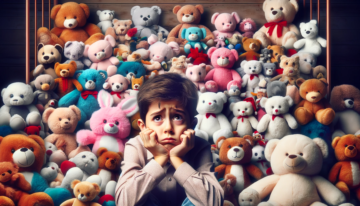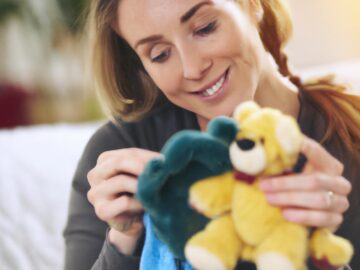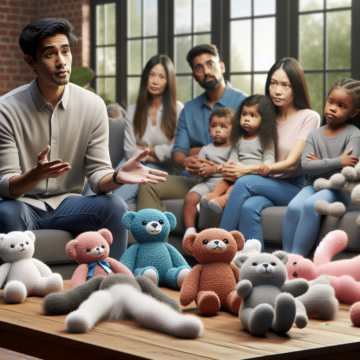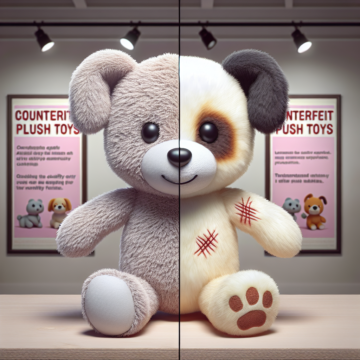
In a world where everyone loves to cuddle up with adorable, soft plushies, it’s disheartening to realize that counterfeit plushies have infiltrated the market. These fake products, while they may seem harmless, can pose a plethora of risks to both consumers and legitimate businesses. This article, ‘Counterfeit Plushies: The Risks and How to Spot Fake Products’, aims to shed light on the dark side of the plush toy industry and equip you with the knowledge to identify authenticity. If you’ve ever found yourself questioning the quality of a plush toy, or if you’re an avid plushie collector looking to protect your investment, this guide is a must-read. Discover the dangers associated with counterfeit plushies, from health hazards to financial implications, and learn effective strategies to separate the genuine from the fake. Step into the world of plush toys and let’s tackle the issue of counterfeit products together.
- 1. Understanding the Dangers of Counterfeit Plush Toys
- 2. Decoding the Manufacturing Quality: Differences between Genuine and Counterfeit Plushies
- 3. Spotting a Fake: Key Indicators of Counterfeit Plush Toys
- 4. The Economic Impact of Counterfeit Plushie Trade
- 5. Protecting Your Purchase: Tips to Avoid Buying Counterfeit Plushies
1. Understanding the Dangers of Counterfeit Plush Toys
The excitement of adding a new plush toy to your collection or gifting it to a loved one can be dampened when you realize that the product is counterfeit. Counterfeit plush toys pose significant dangers that are often overlooked, such as the potential presence of harmful materials and poor construction quality. Unlike authentic plush toys that undergo rigorous safety inspections, counterfeit versions often cut corners, leading to the use of toxic materials like lead or phthalates. These harmful substances can pose serious health risks, especially to children who may frequently come in contact with these toys. Moreover, counterfeit plush toys are often poorly constructed, increasing the risk of small parts coming loose and posing a choking hazard. Understanding these risks underlines the importance of buying authentic plush toys from trusted sources. To avoid falling victim to fake products, it’s crucial to learn how to spot counterfeit plush toys. Look out for tell-tale signs like suspiciously low prices, missing or unprofessional labels, and poor stitching quality. By being vigilant, not only can you ensure the safety of your loved ones, but you also support the brands that invest in creating safe and high-quality plush toys.
2. Decoding the Manufacturing Quality: Differences between Genuine and Counterfeit Plushies
Unraveling the mystery behind the quality of manufacturing plushies can be a complex task, particularly when differentiating between genuine and counterfeit products. Genuine plush toys, often recognized for their superior quality, are meticulously crafted, ensuring that each stitch aligns perfectly, and the fabric used is plush, soft, and non-toxic. Counterfeit plushies, on the other hand, often display inconsistent stitching, substandard fabric, and may contain potentially hazardous materials. These knock-offs not only compromise on quality and safety standards but can also infringe on copyright laws. Therefore, discerning the intricacies of manufacturing quality is critical to ensure you’re bringing home a safe, high-quality toy. By becoming familiar with key quality indicators – checking for labels, examining the craftsmanship, and purchasing from reputable sellers, you can protect yourself and your loved ones from the risks associated with counterfeit products. As consumers, awareness and vigilance are our strongest defense against the burgeoning market of counterfeit plushies.
3. Spotting a Fake: Key Indicators of Counterfeit Plush Toys
Unraveling the world of counterfeit plush toys can be quite daunting, especially when these fake products often look strikingly similar to their genuine counterparts. But, there are key indicators to help you distinguish between a legitimate plush toy and a counterfeit. Firstly, scrutinize the quality of the materials used. Authentic plush toys are crafted with top-quality, durable, and safe materials, while counterfeit versions usually compromise on quality, resulting in a less plush feel. Secondly, check the toy’s packaging and tags. Real plush toys typically have detailed, error-free tags and packaging, while fakes often display poorly printed logos, misspelled words, or lack the necessary safety warnings. Lastly, consider the price point. If the price seems too good to be true, it likely is. Genuine plush toys are often more expensive due to the high-quality materials and manufacturing processes used. By understanding these three key indicators – material quality, packaging, and price – you’ll be better equipped to spot counterfeit plush toys and ensure the safety and satisfaction of your purchase.
4. The Economic Impact of Counterfeit Plushie Trade
The clandestine market of counterfeit plushies poses alarming threats not only to the authenticity and quality of these beloved toys but also to the global economy. The economic repercussions of this illicit trade are far-reaching, with its impact manifesting in several ways. First and foremost, the legitimate plushie manufacturers are losing out on substantial revenue, leading to decreased growth potential and job losses. This, in turn, impacts the government’s tax receipts and stifles innovation. Furthermore, consumers often face the brunt of this illegal activity when they unknowingly purchase substandard, counterfeit products. These fake plushies often lack the safety measures incorporated in genuine products, resulting in unnecessary risks for the end-users. The rippling effects of the counterfeit plushie trade can even extend to environmental concerns, as fake plushies are more likely to be produced without adhering to eco-friendly standards. By prioritizing awareness and understanding about this issue, we can better equip ourselves to spot fake products and contribute to mitigating the economic impact of the counterfeit plushie trade.
5. Protecting Your Purchase: Tips to Avoid Buying Counterfeit Plushies
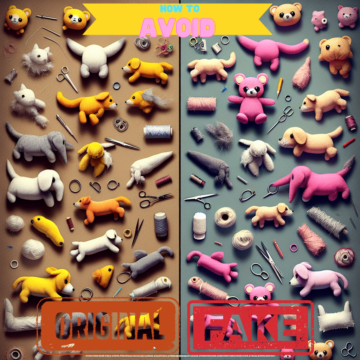
In the delightful world of plush toys, ensuring authenticity is crucial not only for collector’s value but also for the safety of the end-user. Counterfeit plushies might be a tempting bargain, but the risks involved make it wiser to invest in genuine products. From inferior materials to potentially hazardous stuffing, these fakes can pose real dangers, especially to young children. To protect your purchase, it’s essential to know how to spot a counterfeit plushie. Start by verifying the manufacturer’s details and cross-checking them with the information provided on the official website. Authentic plush toys often come with a unique serial number that can be verified online. Additionally, check for the quality of materials used, stitching, and overall craftsmanship. Genuine plushies are made with high-quality materials and demonstrate excellent workmanship. Counterfeits, on the other hand, often have inconsistent stitching and low-grade fabric. Lastly, consider the price. If the deal sounds too good to be true, it probably is. Remember, by avoiding counterfeit plushies, you’re not only securing your investment but also promoting fair trade and supporting original creators.
Conclusion
In conclusion, counterfeit plushies pose numerous risks, presenting not only financial implications but also potential health hazards. The surge in the production and sale of these fake products continues to undermine the toy industry’s integrity, while simultaneously posing threats to unsuspecting consumers.
Throughout this article, we have explored the various risks associated with counterfeit plushies, including exposure to harmful materials, poor quality, and potential copyright infringement. Genuine plush toys adhere to strict safety regulations, ensuring they are safe for children and adults alike. Counterfeit versions, on the other hand, often contain toxic materials that can pose serious health risks, particularly to children.
Moreover, counterfeit plushies are typically of inferior quality. They are often poorly constructed and may break or tear easily, leading to a disappointing experience for the consumer. Furthermore, supporting counterfeit industries promotes intellectual property theft, which can stifle creativity and innovation within the toy industry.
However, we have also provided some insightful tips on how to spot fake products. From examining the product’s packaging and labels to checking the quality of the materials and craftsmanship, these tips should help you make more informed purchasing decisions. By knowing what to look for, you can avoid falling victim to counterfeit scams and ensure you’re getting the real deal.
As we move forward in the digital age, we must become more vigilant consumers. With counterfeit products becoming increasingly sophisticated, it is more important than ever to be able to distinguish between genuine and counterfeit plushies. Moreover, by refusing to support the counterfeit industry, we can help curb its growth and protect the integrity of the toy industry.
Ultimately, the responsibility lies with all of us. We must be discerning, informed consumers, willing to do our part in combating the counterfeit industry. Remember, when it comes to plushies – or any product for that matter – if the deal seems too good to be true, it probably is. Always prioritize safety and quality over a bargain. In doing so, we can ensure a safer, more ethical market for all.
So, the next time you’re shopping for that perfect plushie, take a moment. Look closer. Ask questions. Because each purchase is not just a transaction, but a statement of the kind of world we want to live in.
Remember: In the fight against counterfeit goods, every informed buyer makes a difference.
With this knowledge, let’s strive to be part of the solution, not the problem.
And perhaps, in doing that, we can create a safer world for our children to play in, one plushie at a time.

